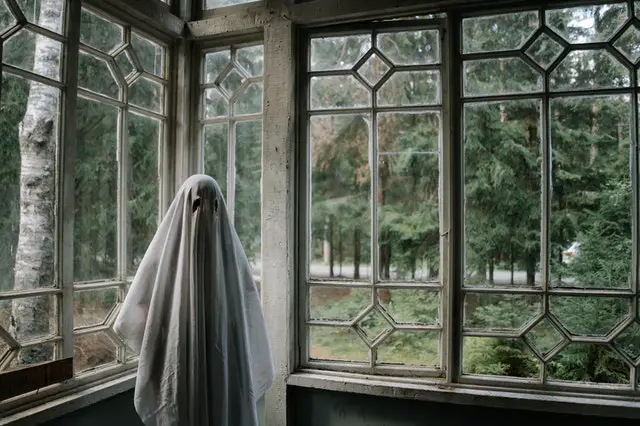Haunted houses have been around since ghosts became a possibility in our minds. It may have started as a haunted cave or castle, but we have haunted houses in modern times.
Whether you believe in ghosts or not, scary old haunted houses likely send a chill down your spine. You probably wouldn’t sleep overnight in one on a dare unless you’ve never seen a haunted house movie before.
Listed below, we’ve got 20 interesting and potentially scary facts about haunted houses you get you ready for the Halloween celebrations.
Warning: Don’t read this alone at night!
1. One of the first haunted houses dates back to Ancient Rome
In AD 1 (it’s now AD 2021), Pliny The Younger wrote of his home being haunted by an old man with a long white beard. This recording is only one of the first recorded haunted houses, which makes you wonder when and how hauntings started.
2. If you buy a haunted house, the seller must let you know
People buy houses all the time, and in some situations, the owner must let the buyer know certain things. For example, it is illegal in some states in the USA to sell a home suspected of being haunted without letting the buyer know.
Failure to do so could result in the new buyer reversing the transaction and getting their money back. On the flip side, the new buyer may have trouble reselling the home if they aren’t made aware of the ghosts in time.
3. Haunted houses have gone corporate and now make 300 million dollars a year
As with many things today, haunted houses are most often thought of as Halloween attractions to scare you safely and for a small fee.
Large attractions can make up to $3,000,000 per year, while smaller attractions can even make $50,000 per year.
Haunted houses are a popular Halloween activity for everyone now.
4. Walt Disney created the first major for-profit haunted house in 1969
Before Walt Disney created his haunted mansion, most haunted houses were low-quality and just cheap scare tactics. With the haunted mansion, Walt Disney brought to life all of the scary parts of a real haunted house.
Using state-of-the-art technology they made ghosts look real and witches talked. It was a fully interactive experience that hadn’t been seen before in a haunted house.
5. There are now more than 2,700 corporate haunted houses in the United States
When I say corporate, I mean you must pay to enter. There’s no count on how many real haunted houses are out there.
However, there is a Haunted House Association with membership, and that membership is over 2,700 in the United States alone. Check out their upcoming events here.
6. Most haunted houses are now run by charities
While haunted houses may be making a lot of money, around 80% of all haunted houses are run by or benefiting local charities. So the money is flowing back into the community and helping people.
7. Haunted houses are becoming less about ghosts and more about shock and fear
Before corporations took over haunted houses, it was generally considered that a spirit was haunting the home and may cause cold spots or move items around the house. You may even hear some noises in the basement.
Nowadays, haunted houses are about shocking you with extreme fright and fear. People may be jumping out and grabbing you or chasing you. You may be eating strange and disgusting things. So the shock factor is being increased, and the competition is high to be the scariest haunted house.
8. Haunted houses are awful for your heart. Don’t enter if you have a bad heart!
With the number of people entering haunted houses every year, especially during Halloween, some haunted houses require you to sign a medical waiver indicating your heart is healthy.
A Today news reporter wore a heart monitor and ventured into a haunted house to see what happened to his heart. His heart jumped to 146 beats per minute multiple times throughout his visit, which is considered intense cardio for a healthy young male. So may not be very healthy for somebody with a heart condition.
9. If you die in a haunted house, people might not notice.
With live performers running around haunted houses or jumping out at you, there are plenty of scary things going on. Unfortunately, there have been multiple occurrences in the US since haunted houses became popular, where performers got into trouble, and nobody noticed until it was too late.
Interestingly enough, most of these performers died by hanging.
10. Real haunted houses may simply be carbon monoxide poisoning
Some theories on real haunted houses suggest that carbon monoxide poisoning is the cause for people believing their homes are haunted.
Many haunted houses have been investigated, and their carbon monoxide levels tested to be extremely high. They are often older houses with older appliances, and most often, hauntings are reported during the winter months.
Carbon monoxide poisoning has the symptoms of feeling like you’re being watched, hearing noises like footsteps or voices, hallucinating, and dizziness.
11. Most haunted houses trace back to somebody dying in the home
In most modern haunted houses, the history of the house has somebody dying there and their spirit not being able to leave for some reason. But, interestingly, most people do die in their homes, so it’s not an unusual situation where a home may have had somebody die.
12. Evolution has made us afraid of haunted houses
When you step into a corporate haunted house, it’s obvious what scared you. People are explicitly trying to scare you any way they can
However, why do some homes get a reputation for being haunted and scare us? When nobody is trying to? Psychologists believe aspects of haunted houses push buttons that we’ve evolved to be afraid of.
These are things like, if somebody tells you a house is haunted or there is a problem, you may not be able to see it, but now your brain is thinking about it. It wants to get out of there to avoid potential harm. So your brain is urging you to brain away fast. Another evolutionary trait is hearing strange noises and being afraid. If you hear something you can’t comprehend or that maybe could be dangerous, your brain wants you to run as well. So you’ve evolved to be afraid of the unknown.
13. The great depression in the US gave rise to haunted houses again
During the great depression, the pranks that young boys played started to escalate. People already angry about money issues were increasingly enraged by the pranks and costs the pranks were causing.
These pranks were certainly not what you would expect today, and they ranged from stealing gates to stealing dead bodies.
Many communities decided to organize haunted houses and Halloween events to bring all young boys together and away from the town to keep them busy and out of trouble.
14. The US White House is considered the most haunted house in the country
There have been numerous sightings of various ghosts and entities at the White House. Winston Churchill and even Ronald Reagan experienced and talked about seeing ghosts there.
This is no wonder as the White House has been occupied since the 1800s, with numerous deaths happening in and around it.
15. Pittlock Mansion in Portland is home to happy, friendly ghosts.
When you think of haunted houses, you think of evil spirits, and ghosts stuck there due to murder or unexpected death. However, the Pittlock Mansion in Portland appears to be home to happy ghosts who love to play.
It’s believed the house’s original owners didn’t have time to live there long enough before they died. So they are spending their ghostly existence enjoying their home and being gracious hosts to anybody that comes.
16. British haunted houses were originally not ghosts
In Britain, haunted houses were originally thought to be fairies living in them and playing tricks on humans. However, it wasn’t until the early 1900s that this idea shifted to being ghosts living and haunting the houses.
This was likely due to the rise of carnivals and attractions. It’s easier to fake a ghost than it is to fake a tiny fairy.
17. Some governments use haunted houses as punishment for their citizens
During the COVID-19 pandemic, Indonesian officials started to lock quarantine violators into abandoned buildings on the Island of Java, many of which are thought to be haunted.
While this may have been just a location to put violators, it was specifically mentioned that they would be placed inside haunted houses as punishment.
18. The first modern commercial house was in 1915, called the Orton and Spooner Ghost House
The Orton and Spooner Ghost house was the first commercial built haunted house. It was explicitly set up to create a fake haunted house to sell tickets and make money.
Prior to this existing, houses were used and then reverted after the event.
19. Haunted houses are vying to become the scariest and offering rewards for people who can stay inside
Like haunted house movies where the characters must stay inside to win money, commercial haunted houses are vying to be the scariest. So owners are offering rewards to customers that can stay inside.
McKamey Manor in Tennessee has previously offered $20,000 if you can stay inside. However, instead of just being a frightening experience, guests are tortured with waterboarding, forced to eat unknown substances, and tied up.
20. Haunted houses are costly to operate, sometimes requiring $100,000+
Gone are the days when you could throw up some white sheets and play scary sounds over a PA system. Haunted houses make big money but also cost big money to operate and market.
Some haunted house operators suggest it could cost up to $100,000 per year and $30,000 per year for marketing; otherwise, you can’t pull in the crowds and make money.
Final Thoughts on Haunted Houses
As you can see, haunted houses have evolved from myths and stories in the community to full scare productions. These new haunted houses are less about scaring you with ghosts and more about just plain terrifying you.
If haunted houses now offer waterboarding, are they haunted houses, or are they torture chambers? I would instead stick with the charity-run fun haunted houses than those offering extreme experiences.
Either way, hopefully, you found the evolution and facts about haunted houses interesting or even informative.



